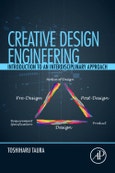This book presents solutions to this topic in different sections that highlight the basic concerns associated with innovation. First, design is considered a kind of universal human act. Second, it is an interdisciplinary approach that brings together perspectives from fields such as cognitive science and science of knowledge is adopted. Third, the scope of the discussion also includes the process of creating an initial idea for a new product (called the pre-design phase), as well as the use of the product in society (the post-design phase).
Design engineers and researchers in engineering design will find this a user-friendly route to understanding the importance of creativity to engineering and how to implement new techniques to improve design outcomes. The book has been translated from the original Japanese book titled Sozo Dezain Kogaku [Creative Design Engineering] (published by the University of Tokyo Press 2014).
Please Note: This is an On Demand product, delivery may take up to 11 working days after payment has been received.
Table of Contents
Chapter 1 Purpose of Creative Design Engineering
Part 1 Motive of design
Chapter 2 Motive of design and the design cycle model
Chapter 3 Aspects of motive of design: One form of inner and outer motive
Part 2 Theory and methodology of concept generation
Chapter 4 The metaphor method: Theory and methodology of concept generation (1st method)
Chapter 5 The blending method: Theory and methodology of concept generation (2nd method)
Chapter 6 Using thematic relation: Theory and methodology of concept generation (3rd method)
Chapter 7 Abduction and concept generation
Chapter 8 Basic principles of concept generation
Part 3 Theory and methodology of conceptual design
Chapter 9 Methodology of conceptual design
Chapter 10 Basic principles of conceptual design
Part 4 Design ability and sociality
Chapter 11 Abilities required for creative design thinking and transferring these
Chapter 12 From product design to technology design
Chapter 13 The significance of creative design engineering








